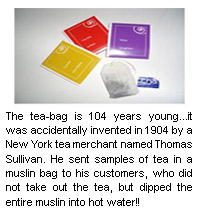Tea Firsts
- According to legend, in 2737 BC, Chinese emperor Shen Nung was sitting beneath a tree while his servant was boiling some water for drinking, when some leaves accidentally dropped in the water. Shen Nung was a renowned herbalist, and decided to try the brew his servant had accidentally created. The tree was Camellia Sinensis, and the drink is what we now call TEA!
- Containers for tea have been found in tombs dating back to the Hun dynasty (206BC - 220AD).
- In 350AD, a chinese dictionary cites tea for the first time as Erh Ya
- It was under the Tang dynasty (618-906AD) that tea became firmly established as China's national drink.
- In 725AD, the Chinese give tea its own character - "
 "- ch'a.
"- ch'a. - In 780AD, the first tax on tea is imposed in China.
- The first book on TEA was written by Lu Yu in the late eighth century and was called Cha'Ching, or Tea Classic!
- Shortly after this, Japanese monks who came to China to study Buddhism, introduced Tea to Japan. The Japanese Tea Ceremony has its roots in the rituals described in Cha'Ching.
- In late 15th century, the Japanese Tea Ceremony emerges. Called Cha-no'yu, it literally means "hot water tea".
- In 1598, the Dutch traveler Jan Hugo van Lin-schooten, noted in a book about his adventures that the Indians ate the leaves as a vegetable with garlic and oil and boiled the leaves to make a brew. He called the beverage CHAA.
- It was the PORTUGESE who first introduced tea to Europe - Father Jasper de Cruz, a Portuguese Jesuit, got tea to Europe in 1560.
- It was the DUTCH who first shipped a commercial lot of tea to Europe, in late 16th century
- It was QUEEN CATHERINE OF BRAGANZA, a Portuguese princess, who married CHARLES II in 1662, who made Tea fashionable in the courtly and aristocratic circles in Britain.
- The FIRST SALE of Tea in Britain was done in 1657 by the East India Company as it undercut the Dutch prices. Tea was advertised as panacea for apoplexy, catarrh, colic, consumption, drowsiness, epilepsy, gallstones, lethargy, migraine, paralysis, and vertigo.
- The first dated reference to TEA in Britain was in September 1658 : a London newspaper MERCURIUS POLITICUS, announced " excellent and by all Physitians approved China Drink called by the Chineans Tcha, by other nations Tay, alias Tea, is sold at the Sultaness Head, a cophee-house in Sweeti Rents."
- The FIRST shipment of Tea to Britain was done in 1664 : the East India Company placed an order for 100lbs of China Tea to be shipped from Java into Britain.
- The first tea was sold in London Tea Auction in 1679 - auctions were then held on a quarterly basis - and teas were " sold by candle" . the time taken for each tea to be sold was 1 inch of the burning candle!
- The first TAX on TEA was introduced in Britain in 1689 - 25p per pound! It was so high that it almost stopped tea sales.
- The grand tradition of London Tea Auction ended on 29th June, 1998.
- In 1707, Thomas Twining serves Tea at Tom's Coffee House in London.
- In 1717, Tom's Coffee House evolves into Golden Lyon - the first teashop!
- In 1823 and 1831, Robert Bruce and his brother Charles, an employee of the East India Company, confirmed that the tea plant was indeed a native of the Assam area and sent seeds and specimen plants to officials at the newly established Botanical Gardens in Calcutta. But again, nothing was done - perhaps because the East India Company had a monopoly on the trading of tea from China and, as they were doing very nicely, probably saw no reason to spend time and money elsewhere
- The first twelve chests of manufactured tea to be made from indigenous Assam leaf were shipped to London in 1838 and were sold at the London auctions. The East India Company wrote to Assam to say that the teas had been well received by some "houses of character", and there was a similar response to the next shipment, some buyers declaring it "excellent".
- In 1826, the first tea is retailed in sealed packages under proprietary name by English quaker John Horniman.
- In 1834, the London Auctions shifted to Mincing Lane, and in a few years, all merchants establishments had their offices in Mincing Lane, and it came to be known as the " Street of Tea"
- In 1849, Henry Charles Harrod of 49 Eastcheap, takes over a grocery shop at 8 Brompton Road, London, that will grow to become the world's largest departmental store.
- In 1850, the first Tea Clipper - THE ORIENTAL, arrives at London from Hong Kong after a 97 day voyage, carrying 1600 tonnes of China Tea.
- In 1870, Twining starts blending tea for the first time for uniformity.
- In 1876, Thomas Johnstone Lipton, opens his first grocery shop in Glasgow.
- In 1893, Thomas Lipton registers a new trade-mark for tea he has been selling in packages since 1890. Over the facsimile signature " Thomas J Lipton, Tea Planter, Ceylon", Lipton prints the words " non genuine without this signature".
- In 1904, Thomas Sullivan, a New York grocer, accidentally invents the tea-bag, when he sends samples of his tea blends to his customers in hand-made muslin bags.
- In 1904, Iced tea is created by Richard Blechynden, at St. Louis fair.
- In 1953, White Rose Redi-Tea is introduced by New York's SEEMAN BROS. - the world's first instant tea.





